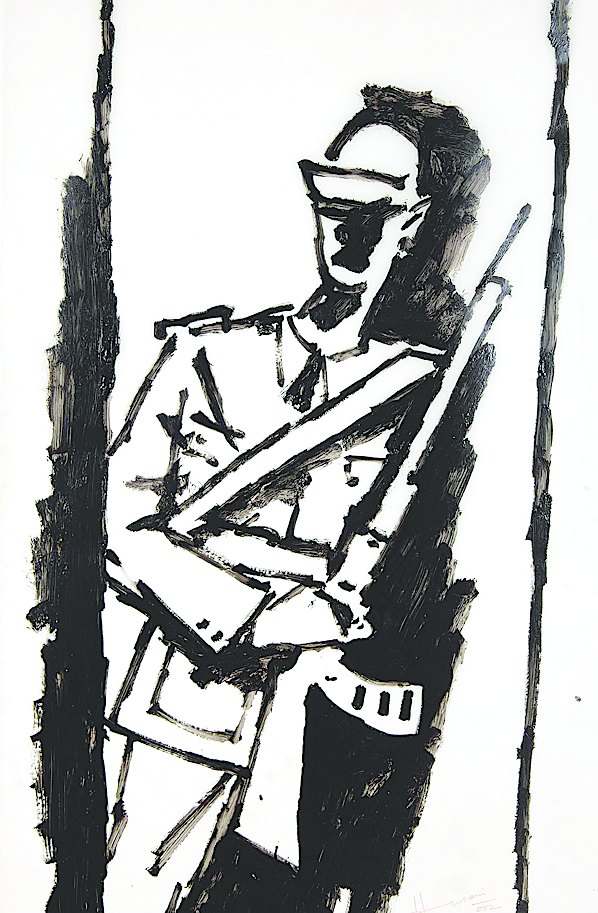
Drawings may form the basis of paintings, providing the armature for mounting the paintwork, but on their own, too, without the aid of pigment, lines can make a strong enough impression as works of art. This becomes adequately clear as one steps into CIMA Art Gallery, where the exhibition, Drawings & In Between, is on till January 10. The first image one encounters is of M.F. Husain's large impromptu drawing with a brush and black acrylic paint on tracing film titled, Knight Watch, an obvious pun on Rembrandt's masterpiece. It can be argued that Husain's paintings are actually very strong drawings, with pigment adding vibrancy to an already sinewy formation. With or without colour, nobody could doubt the strength of their aesthetics. And this holds true for the drawing on display done at this gallery itself in 2002 after the Gujarat riots.
Husain's lines are terse. A uniformed man holds a firearm in one hand. The visor of his cap casts a shadow on his face, and he is framed by deeper shadows on both sides. He could be from Kashmir or from any other troubled state. It speaks for itself as a sign of our times. This exhibition gives viewers an overview of the history of drawing in Bengal from early 19th century onwards, the gaps notwithstanding. It has lined up quite a few outstanding works of the great early practitioners. Upendrakishore Raychaudhuri's simple illustrations of Hindusthani Upakatha series (a Bengali translation of the English, Shaikh Chilli, collected and rewritten for Modern Review by Srisacandra Basu and later translated into Bengali by Santa Devi, daughter of Ramananda Chattopadhyay) are rarely seen as they belong to a private collection. The medium is watercolour and ink on paper. The naughty sense of humour is inimitable.
There are Rabindranath's mysterious Portrait of a Lady in pen and ink, Gaganendranath's Bande Mataram, a tribute to Jagadish Chandra Bose's experiments on plant perception, Ramkinkar Baij's sketch, and Jamini Roy's Woman in curvaceous drapes. Atul Bose's fine studies of a nude and of a young woman in her study hark back to the academic training that still holds sway in Calcutta. So much for history. The rest of the exhibits chart the diverse nature of works that come under the rubric of drawing.
If Ramananda Bandyopadhyay's decorative lines delineate a young woman inclined to embonpoint, K.G. Subramanyan rewrites the myths of avatars in a perfectly delightful manner, cocking a snook at all orthodox readings of sacred texts. Chintan Upadhyay's sinister bionic baby in New Media Café affords us a glimpse of a future latched on to technology, while the sculptor, N.N. Rimzon, and the Gond artists, Jangarh Singh Shyam, his son, Mayank, and Ram Singh Urveti celebrate man's communion with nature. Paramjit Singh also reaches out to nature in his evocative drawing with charcoal of a landscape overgrown with babul shrubbery.
Yusuf's ink-and-acrylic-on-canvas compositions are near-perfect in their poise and serenity, the shape-changing configurations with their delicate, tendril-like lines as insubstantial as the white fluffy seeds of thistles that blow in the wind. Sushen Ghosh uses almost the same lines, but the effect in his structured compositions is absolutely different. Lines take on a character and personality of their own in R.M. Palaniappan's drawing titled A Common Interest. They seem to be the fruits of hours of contemplation. Then, with a swift and sure stroke of crayon, he describes the taut lines. Calm and tranquillity prevail in Ram Kumar's drawing done in 1961. Here again, the composition is entirely dependent on lines and cross-hatchings.
Lines can be equally explosive, as in Manu Parekh's sexually-charged work with their splashes of black and red. Amitava Das seems to have left off the decorative mode, and one misses the energy of his black creepers which often engulfed an entire canvas like vines growing in the wilderness. Here he is far more subdued and restrained.
Maidens, stark naked, roam around forests where ithyphallic trees thrive in K. Laxma Goud's meticulous pencil drawing. She is shackled, restrained and shorn of her locks as she sits forlorn with a red bloom in Arpita Singh's Do Not Put Flower in Your Hair. She is, in fact, composed of the words of the title. Madhvi Parekh's Head - I (acrylic and charcoal on paper) is naïve and full of fun. Both T. Vaikuntam (charcoal on canvas) and Lalu Prasad Shaw take a quizzical look at men and their foibles. All these drawings have one thing in common. Never mind the medium, it is the power of lines that matters.

